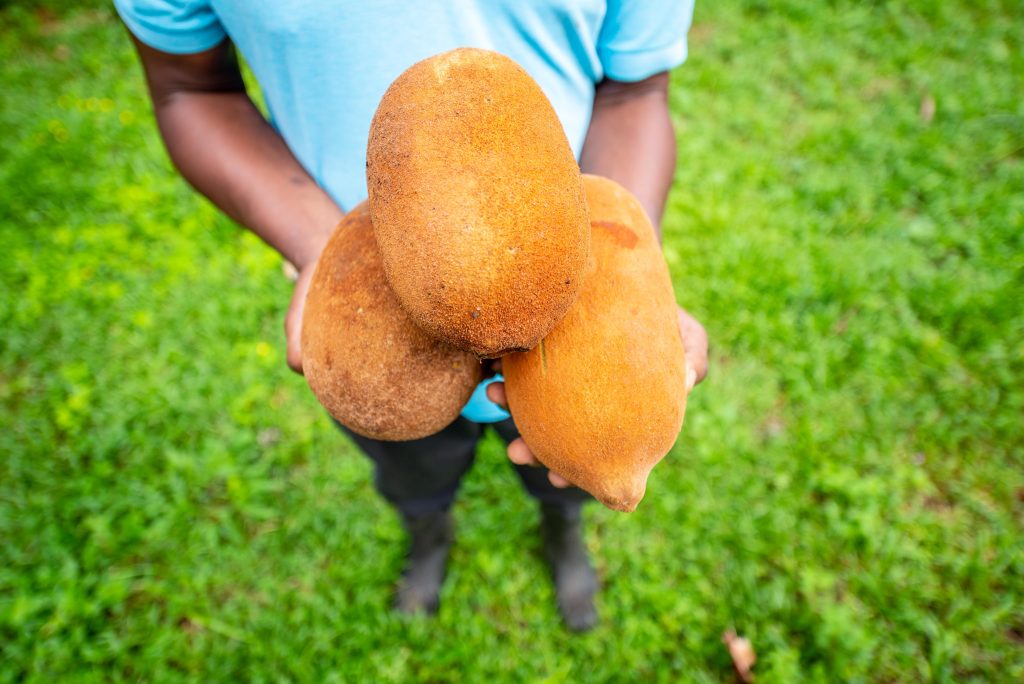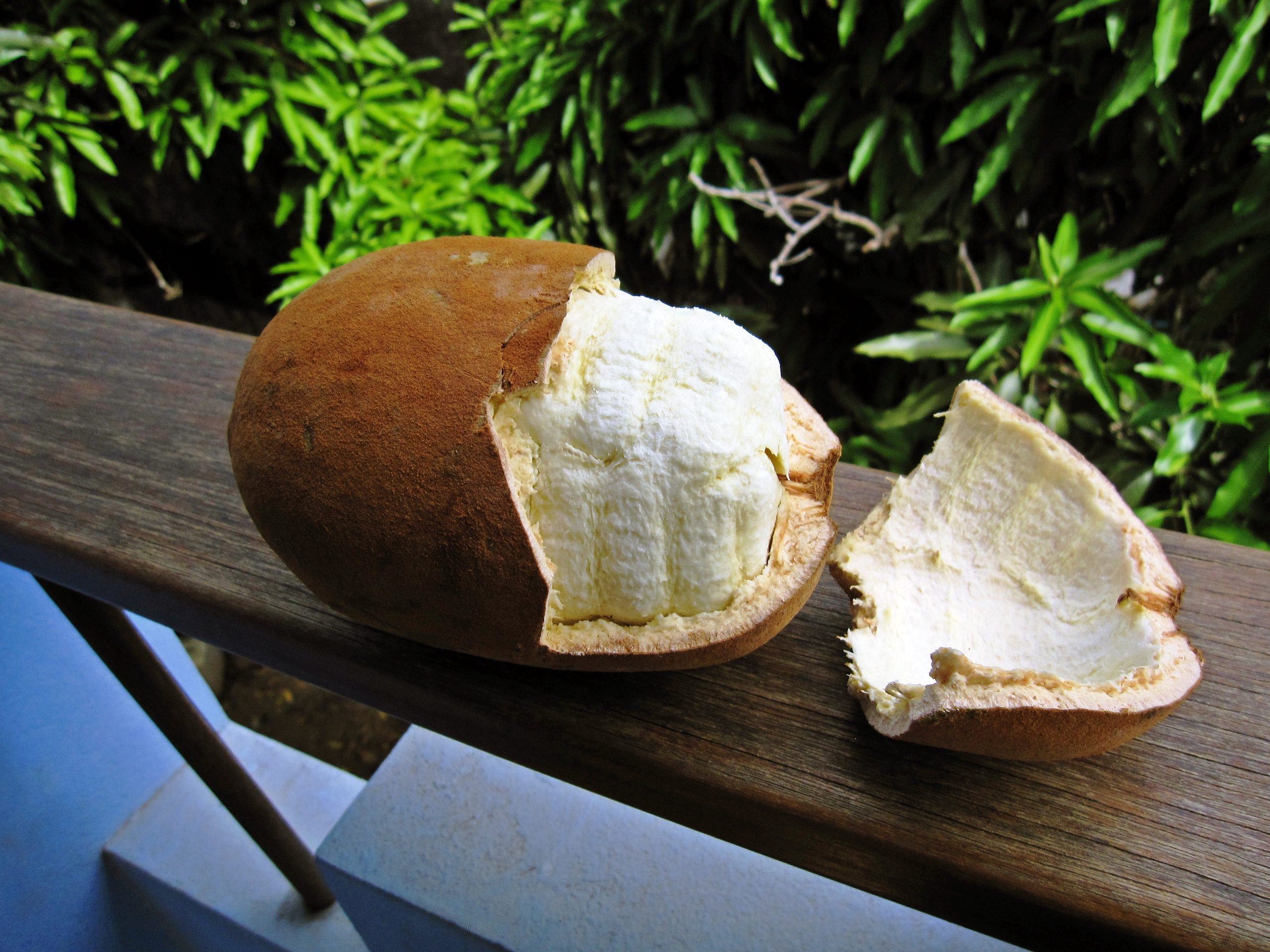Cupuaçu, the exotic fruit native to the Amazon rainforest, is capturing the attention of food enthusiasts worldwide. With its unique flavor profile, creamy texture, and rich aroma, cupuaçu is often hailed as the "fruit that melts like butter." This tropical delicacy is gaining popularity for its delicious taste, potential health benefits, and versatile culinary uses.
Table of Contents
What is a Cupuaçu?
Cupuaçu (pronounced koo-poo-ah-soo) is a tropical fruit native to the Amazon rainforest region of South America, mainly found in Brazil, Colombia, Peru, and Bolivia. It belongs to the same plant family as cacao (Theobroma cacao) and is often referred to as the “cousin of cocoa” due to its resemblance in appearance and some flavor notes.
Scientifically known as Theobroma grandiflorum, cupuaçu goes by various other names in different regions. In Brazil, it is commonly called “cupuaçu,” which means “food for the gods” in the indigenous Tupi-Guarani language. In Peru, it is known as “copoazú,” while in Colombia, it is called “cupuazú.”
Visually, the cupuaçu fruit is large, typically measuring around 15 to 25 centimeters (6 to 10 inches) in length. It has a thick, woody rind covered in fine, brownish hairs.
The fruit’s shape is similar to that of a pear or an oblong melon. When fully ripe, the rind turns from green to brown and becomes slightly softer, making it easier to open.
Inside the cupuaçu fruit is a white, creamy pulp surrounding several large seeds. The pulp is the edible part of the fruit known for its unique flavor and aroma.
Cupuaçu’s flavor profile is often described as a harmonious blend of tropical notes with hints of pineapple, banana, and pear. The pulp has a creamy, velvety texture that melts in the mouth, providing a refreshing and mildly acidic sensation. Its taste is sweet and tangy, striking a balance between the two.
Cupuaçu butter is a popular preparation of the fruit and is full of saturated and unsaturated fatty acids. It melts easily, around 30 degrees Celsius, and has a soft solid form, similar to white chocolate. It’s often used in sweets because of this.
The History of Cupuaçu
The story of cupuaçu is deeply woven into the tapestry of Brazil’s rich biodiversity, tracing its roots back to the territories of the south and southeast Amazonia, with a significant presence in Para and Maranhao states.
Today, you can find these fruits basking in the warmth near the veins of Amazonia: the mighty Xingu, Tapajos, and Guama rivers.
The footprints of the aboriginal settlers of this region, dating back to pre-Columbian times, are embedded in the cultivation of the fruit. Teasing apart its natural evolution from human intervention proves a fascinating and challenging task.
Fast forward to the present day, and this tropical marvel graces a large swath of Brazil, from the southern stretches of São Paulo state to the northern expanses of Roraima state. The cupuaçu tree often stands tall and proud in local backyards, a testament to its cultural significance despite the absence of extensive commercial plantations.
Yet, the allure of cupuaçu extends far beyond Brazil’s borders. Its cultivation has started to spread across the globe, making a modest but meaningful appearance in Colombia, Trinidad and Tobago, Guyana, Ecuador, Venezuela, Costa Rica, Martinique, and even the far-off African lands of Ghana.

What Does a Cupuaçu Taste Like?
Cupuaçu is frequently compared to a blend of flavors from bananas, pears, passion fruit, and melon, with a touch of tartness like that of pineapple or lemon. It also has a rich, creamy texture similar to a ripe avocado. Additionally, there are notes of chocolate in its flavor profile. Hence it is sometimes referred to as the “chocolatey fruit.”
The cupuaçu’s white pulp is juicy, slightly acidic, and aromatic. It’s often eaten straight from the fruit or used in desserts, ice creams, or smoothies. The tart and tangy flavor strengthens when the fruit is fully ripe.
When cooked, the flavor of cupuaçu becomes a bit mellower. The pulp can also be processed into butter, similar to cocoa butter used in chocolates and confections. In this form, it carries a delicate, exotic fruity flavor with a hint of creamy, cocoa-like notes.
How to Tell When Cupuaçu is Ripe
To determine when cupuaçu is ripe, you can consider the following characteristics:
| Color | Ripe cupuaçu fruits turn from green to brown or dark brown as they mature. Look for a deep, rich color on the outer skin. |
| Texture | Gently press the fruit. A ripe cupuaçu should yield slightly to gentle pressure, indicating a softer texture. |
| Firmness | Avoid overly soft or mushy fruits, which may be overripe or spoiled. The fruit should have a slight firmness when gently squeezed. |
| Scent | Ripe cupuaçu emits a sweet, aromatic fragrance. |
Are Cupuaçu and Cacao Related?
Indeed, both cacao (Theobroma cacao) and cupuaçu (Theobroma grandiflorum) belong to the Malvaceae family, and more specifically, they’re both from the Theobroma genus. The word “Theobroma” comes from Greek and means “food of the gods.” Despite their genetic closeness, these two tropical fruits have some interesting differences.
Similarities
| Habitat | Both trees are native to the tropical rainforests of Central and South America. They need a hot, humid climate to grow and thrive. |
| Fruit Structure | Both species’ fruits are large pods with seeds embedded in a sweet-sour pulp. |
| Cultivation and Harvesting | Both cacao and cupuaçu trees require similar cultivation methods, and their fruits are typically hand-harvested. |
| Usage | The seeds (or beans) of both fruits can be processed to extract butter and powder, used in the production of chocolates, cosmetics, and various food products. |
Differences
| Taste | Cacao pods produce beans which are the primary ingredient in chocolate. They taste bitter and must be fermented, dried, roasted, and processed to make the chocolate we know and love. Cupuaçu, on the other hand, has a unique flavor described as a blend of chocolate, banana, melon, and pineapple. The pulp is naturally sweet-sour, and it’s often used in desserts, juices, ice creams, and jellies in its native regions. |
| Size | Cupuaçu pods are generally larger than cacao pods. Cupuaçu pods can reach up to 20 cm in length and weigh up to 2 kg, while cacao pods typically reach around 10 cm long and are lighter. |
| Theobromine Content | Cacao is well-known for its high theobromine content, a compound that is similar to caffeine, but cupuaçu does not contain this compound. |
| Cultivation | Cacao is grown and harvested globally on a much larger scale. |
Can I Eat Raw Cupuaçu?
Certainly! Raw cupuaçu fruit can be used in various applications:
- You can enjoy the raw cupuaçu fruit by peeling it and eating the creamy pulp.
- Blend the raw cupuaçu pulp with other fruits, such as bananas, berries, or mangoes, to create delicious and nutritious smoothies or juices.
- Raw cupuaçu fruit can be incorporated into desserts like mousses, ice creams, or sorbets.
- The raw cupuaçu pulp can be used as a base for sauces or dressings. Combine it with other ingredients like lime juice, honey, or herbs to create flavorful accompaniments for savory dishes.
Cooking with Cupuaçu
Cupuaçu is versatile and can be used in various culinary preparations, from sweet desserts to savory dishes. Before diving into specific recipes, let’s go over how to prepare the fruit for cooking:
- Choose cupuaçu fruit that is ripe and slightly soft to the touch. Ripe fruit will have a pleasant aroma and a dark brown exterior.
- Cut the fruit in half, lengthwise. Inside, you will find several large seeds surrounded by a creamy white pulp. Gently scoop out the seeds and reserve them for later use. The pulp is the edible part of the fruit used in cooking.
- Scrape it away from the skin using a spoon and transfer it to a bowl. You can also use your hands to separate the pulp from the seeds.
Cupuaçu is widely used in Brazilian cuisine, especially in the Amazon region. It is a popular ingredient in desserts, beverages, ice creams, sauces, and even savory dishes.

Here are three examples of specific dishes:
Cupuaçu-Chocolate Brownie with Brazilian Nuts: The marriage of cupuaçu’s tangy intensity with the silken allure of chocolate creates an exotic and sophisticated brownie. But the true unsung hero here? The Brazilian nuts!
Cupuacu Mousse: This is not just any mousse; this is a flavor roller coaster that demands your taste buds to buckle up. The cupuaçu gives it a tart yet tropical sweetness.
Chocolate Cake with Cupuacu: This cake carries all the traditional decadence of a chocolate cake but throws a curveball in the form of cupuaçu. Its tropical tartness cuts through the rich chocolate, creating a bittersweet symphony that plays the tastiest tune on your palate.
How to Store Cupuaçu
Cupuaçu is best consumed when ripe. If the fruit is fully ripe, it can be stored at room temperature for a few days, usually up to 2-3 days. However, it is essential to note that cupuaçu ripens quickly, so it’s best to consume it as soon as possible to enjoy its optimal flavor.
If you want to extend the shelf life of cupuaçu, you can store it in the refrigerator. Place the fruit in a plastic bag or an airtight container to prevent moisture loss. When stored properly, cupuaçu can last 5-7 days in the refrigerator.
Cupuaçu can also be frozen for longer-term storage. To freeze cupuaçu, remove the skin and seeds, and cut the fruit into smaller pieces. Place the pieces in an airtight container or freezer bag, removing as much air as possible. Frozen cupuaçu can be stored for up to 6 months in the freezer. Thawed cupuaçu may have a slightly softer texture but can still be used in smoothies, desserts, or other recipes.
Nutritional Benefits of Cupuaçu
Cupuacu has some potential health benefits worth mentioning.
Epicatechin, also found in cocoa and berries, could boost cerebral health. Improving blood circulation, particularly in the brain, can enhance memory and quicken information processing, though more studies are required for definitive claims. More so, it can potentially lessen inflammation that might contribute to cancer.
Quercetin, a plant pigment in cupuaçu, acts as a heart protector. It initiates the breakdown of fat cells while curbing new ones from forming and inhibiting glucose absorption. Quercetin also has antibacterial and antiviral properties.
The South American populace uses cupuaçu seed butter as a top-rated skin hydrator. It’s superior to shea butter or lanolin because it can penetrate deep into the skin, retain moisture, and revitalize elasticity.
Lastly, the fiber content in cupuaçu can create a feeling of satiety and help curb food cravings, thereby aiding weight loss.
The Other Uses of Cupuaçu
Beyond its culinary uses, cupuaçu is also a valuable ingredient in hair and skin care products due to its abundant nutritional and moisturizing properties.
Skin Care Products
Cupuaçu is packed with antioxidants, vitamins, and minerals essential for skin health. In particular, it’s rich in vitamin C, which helps to promote a brighter complexion and to neutralize harmful free radicals that can damage the skin. Cupuacu seed extract also has regenerative properties.
Cupuaçu butter is a common derivative of the fruit used in various skincare products such as lotions, creams, and balms. It’s renowned for its superior moisturizing capabilities, often compared to shea butter, but can provide 200% more moisture. This makes it an attractive ingredient in products aimed at dry, damaged, or aging skin.
Hair Care Products
When it comes to hair care, cupuaçu is equally beneficial. It’s frequently found in hair conditioners, masks, and serums due to its potent hydration and nourishing properties.
Cupuaçu butter is a fabulous emollient that helps provide moisture to hair strands, offering a soft, smooth texture and promoting shine.
Its high content of essential fatty acids also nourishes the scalp, promoting a healthy environment for hair growth while also protecting hair from environmental stressors like pollution and UV rays.
Where to Purchase Cupuaçu
If you are in South America, particularly in Brazil, Peru, or Colombia, you will likely find Cupuaçu in local markets or grocery stores, especially during the peak season from January to April. You might also find it in areas with a significant South American population.
In regions where Cupuaçu is not native, you might find it in specialty grocery stores or markets focusing on exotic or tropical fruits. Many online retailers and health food stores sell Cupuaçu products, including fresh fruit, frozen pulp, supplements, and powder. Some of these online retailers ship internationally.
Note: The availability of Cupuaçu in fresh form outside of South America might be limited due to its short shelf life and the challenges associated with transporting it. However, processed forms like powders, pulps, and supplements are more widely available.

